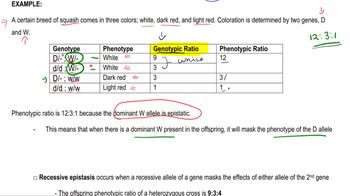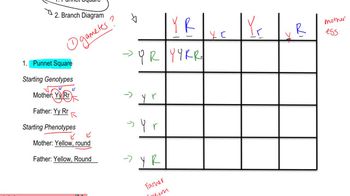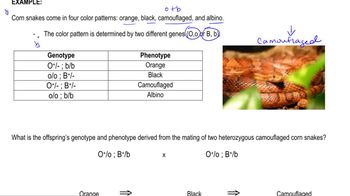Table of contents
- 1. Introduction to Genetics51m
- 2. Mendel's Laws of Inheritance3h 37m
- 3. Extensions to Mendelian Inheritance2h 41m
- 4. Genetic Mapping and Linkage2h 28m
- 5. Genetics of Bacteria and Viruses1h 21m
- 6. Chromosomal Variation1h 48m
- 7. DNA and Chromosome Structure56m
- 8. DNA Replication1h 10m
- 9. Mitosis and Meiosis1h 34m
- 10. Transcription1h 0m
- 11. Translation58m
- 12. Gene Regulation in Prokaryotes1h 19m
- 13. Gene Regulation in Eukaryotes44m
- 14. Genetic Control of Development44m
- 15. Genomes and Genomics1h 50m
- 16. Transposable Elements47m
- 17. Mutation, Repair, and Recombination1h 6m
- 18. Molecular Genetic Tools19m
- 19. Cancer Genetics29m
- 20. Quantitative Genetics1h 26m
- 21. Population Genetics50m
- 22. Evolutionary Genetics29m
3. Extensions to Mendelian Inheritance
Epistasis and Complementation
Problem 37a
Textbook Question
Epistatic gene interaction results in a modification of the F₂ dihybrid ratio.
Give two examples of modified F₂ ratios produced by epistatic gene interactions and describe how gene interaction results in the ratios.
 Verified step by step guidance
Verified step by step guidance1
<span>Identify the concept of epistasis: Epistasis occurs when the effect of one gene is dependent on the presence of one or more 'modifier genes'. This interaction can alter the expected phenotypic ratios in genetic crosses.</span>
<span>Example 1: Recessive Epistasis - In this type of interaction, the presence of two recessive alleles at one locus masks the expression of alleles at a second locus. This often results in a modified 9:3:3:1 ratio to a 9:3:4 ratio in the F₂ generation.</span>
<span>Example 2: Dominant Epistasis - Here, a dominant allele at one locus masks the expression of alleles at a second locus. This can modify the typical 9:3:3:1 ratio to a 12:3:1 ratio in the F₂ generation.</span>
<span>Explain the mechanism: In recessive epistasis, the recessive alleles at the epistatic locus prevent the expression of alleles at the hypostatic locus, leading to a different phenotypic outcome. In dominant epistasis, the dominant allele at the epistatic locus overrides the expression of alleles at the hypostatic locus.</span>
<span>Summarize the impact: These interactions demonstrate how genetic pathways can be influenced by multiple genes, leading to phenotypic ratios that deviate from Mendelian expectations.</span>
Recommended similar problem, with video answer:
 Verified Solution
Verified SolutionThis video solution was recommended by our tutors as helpful for the problem above
Video duration:
4mPlay a video:
Was this helpful?
Key Concepts
Here are the essential concepts you must grasp in order to answer the question correctly.
Epistasis
Epistasis refers to the interaction between genes where the expression of one gene is affected by one or more other genes. This can lead to modified phenotypic ratios in offspring, particularly in dihybrid crosses. For example, in a classic case, one gene may mask the effect of another, altering the expected Mendelian ratios.
Recommended video:
Guided course

Epistatic Genes
Dihybrid Cross
A dihybrid cross involves two traits, each controlled by different genes, typically represented by two pairs of alleles. The expected phenotypic ratio in a standard dihybrid cross is 9:3:3:1. However, when epistasis occurs, this ratio can change, leading to different proportions of phenotypes in the offspring.
Recommended video:
Guided course

Punnet Square
Modified F₂ Ratios
Modified F₂ ratios arise when epistatic interactions alter the expected outcomes of a genetic cross. For instance, in a case of recessive epistasis, the ratio may shift from 9:3:3:1 to 9:7, indicating that certain combinations of alleles prevent the expression of other traits. Understanding these modifications is crucial for predicting phenotypic outcomes in genetic studies.
Recommended video:
Guided course

F Factor and Hfr

 5:05m
5:05mWatch next
Master Complementation with a bite sized video explanation from Kylia Goodner
Start learning



